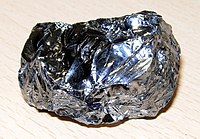
Photo from wikipedia
The performance of C2-symmetric ansa-hafnocene catalysts for isotactic polypropylene typically deteriorates at increasing temperature much faster than that of their zirconium analogues. Herein, we analyze in detail a set of… Click to show full abstract
The performance of C2-symmetric ansa-hafnocene catalysts for isotactic polypropylene typically deteriorates at increasing temperature much faster than that of their zirconium analogues. Herein, we analyze in detail a set of five Hf/Zr metallocene pairs—including some of the latest generation catalysts—at medium- to high-polymerization temperature. Quantitative structure–activity relationship (QSAR) models for stereoselectivity, the ratio allyl/vinyl chain ends, and 2,1/3,1 misinsertions in the polymer indicate a strong dependence of polymerization performance on electrophilicity of the catalyst, which is a function of the ligand framework and the metal center. Based on this insight, the stronger performance decline of hafnocenes is ascribed to electrophilicity-dependent stabilization effects.
Journal Title: Polymers
Year Published: 2021
Link to full text (if available)
Share on Social Media: Sign Up to like & get
recommendations!